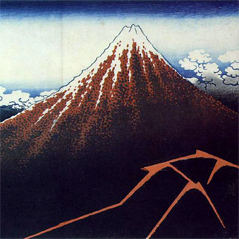|
Why Fujiyama Dojo?
|
Fujiyama Dojo P.O. Box 20003 Thorold, ON, Canada L2V 5B3 (905) 680-6389 |
|---|
 The name of the dojo must define its character, its spirit and its goal. It does not to be graceful sounding or impressive. It must, however, be true. Fujiyama, of Fuji San, as it would be pronounced in Japan, is a dormant volcano with the highest peak in Japan. It has an altitude of 3,776 m (approx. 12,389 ft.). There are five lakes at the northern base of the mountain, the easternmost being Yamanaka, then Kawaguchi, Saiko, Shoji, and then Motosu in the west. As a tourist attraction, it is a beautiful place to visit that can be reached in about two hours and ten minutes by train from Shinjuku (Tokyo) to Kawaguchi Station.
But the meaning of Fuji San goes far beyond sightseeing and tourism. The mountain has always been a symbol of Japan, its traditions and history. Fuji is sometimes written with the characters meaning "not second" or "hot two", expressing the non-duality of a correct nature, becoming to a shugyosha, or Budoka: singleness of thought, goal and spirit. From it, we can learn its calm presence, its immovable stance, its simplicity. It needs not boast, because it just is.
Junichiro Tanizaki wrote of Fuji San: "It must be the first thing we see when we wake up or arrive, and the last thing we see before we leave or fall asleep." He spoke of the nature of an individual, this main ideal or motivation in life, of course. But beauty, the characteristics of Mount Fuji, is a perfect description. For a student, calmness of spirit, strength of purpose in training, inner peace, appreciation of beauty, as well as cultivation beauty of thought are virtues to be cherished and pursued. Fuji San reminds us of that. A single incongruous note and all is lost.
It was to the north side of Mount Fuji, tradition tells us, that the first dojo specialized in the teaching of Aiki Jujutsu existed, during the 13th century. It was kept secret, and only a few were admitted, but the art, like the mountain, survives.
It has been said that, "It takes about nine hours to reach the summit of Fuji San, but a lifetime to realize its meaning." And so it is with Budo.
There is a limited number of techniques, but nothing would be achieved unless we look deeper, without rushing. We dare not compare the dojo to the mountain in magnitude, but we hope to remind ourselves of what it symbolizes, and from it learn humility, respect, and perseverance, as well as delighting in the beauty of life, as the mountain shows itself to us; one day at a time, one technique at a time. The name of the dojo must define its character, its spirit and its goal. It does not to be graceful sounding or impressive. It must, however, be true. Fujiyama, of Fuji San, as it would be pronounced in Japan, is a dormant volcano with the highest peak in Japan. It has an altitude of 3,776 m (approx. 12,389 ft.). There are five lakes at the northern base of the mountain, the easternmost being Yamanaka, then Kawaguchi, Saiko, Shoji, and then Motosu in the west. As a tourist attraction, it is a beautiful place to visit that can be reached in about two hours and ten minutes by train from Shinjuku (Tokyo) to Kawaguchi Station.
But the meaning of Fuji San goes far beyond sightseeing and tourism. The mountain has always been a symbol of Japan, its traditions and history. Fuji is sometimes written with the characters meaning "not second" or "hot two", expressing the non-duality of a correct nature, becoming to a shugyosha, or Budoka: singleness of thought, goal and spirit. From it, we can learn its calm presence, its immovable stance, its simplicity. It needs not boast, because it just is.
Junichiro Tanizaki wrote of Fuji San: "It must be the first thing we see when we wake up or arrive, and the last thing we see before we leave or fall asleep." He spoke of the nature of an individual, this main ideal or motivation in life, of course. But beauty, the characteristics of Mount Fuji, is a perfect description. For a student, calmness of spirit, strength of purpose in training, inner peace, appreciation of beauty, as well as cultivation beauty of thought are virtues to be cherished and pursued. Fuji San reminds us of that. A single incongruous note and all is lost.
It was to the north side of Mount Fuji, tradition tells us, that the first dojo specialized in the teaching of Aiki Jujutsu existed, during the 13th century. It was kept secret, and only a few were admitted, but the art, like the mountain, survives.
It has been said that, "It takes about nine hours to reach the summit of Fuji San, but a lifetime to realize its meaning." And so it is with Budo.
There is a limited number of techniques, but nothing would be achieved unless we look deeper, without rushing. We dare not compare the dojo to the mountain in magnitude, but we hope to remind ourselves of what it symbolizes, and from it learn humility, respect, and perseverance, as well as delighting in the beauty of life, as the mountain shows itself to us; one day at a time, one technique at a time.
|
|---|


